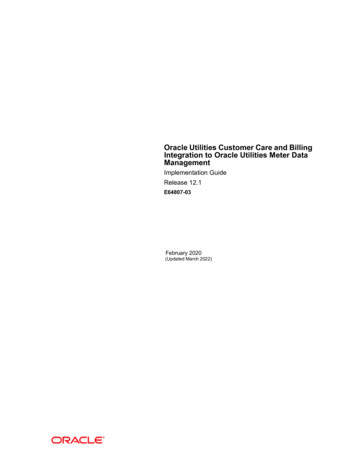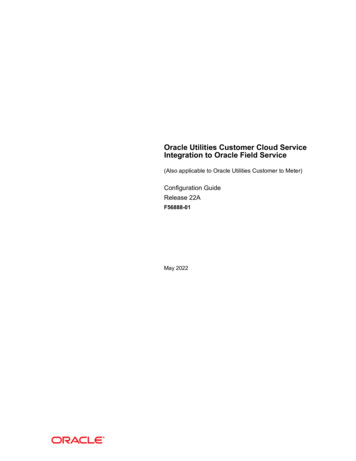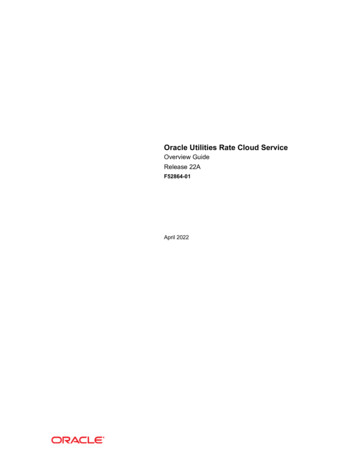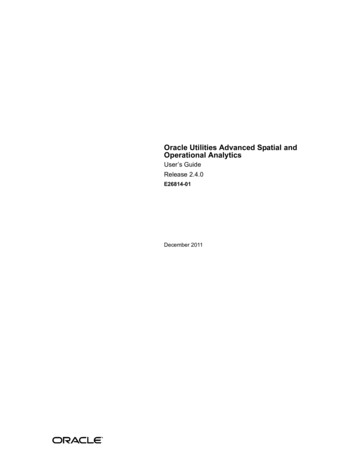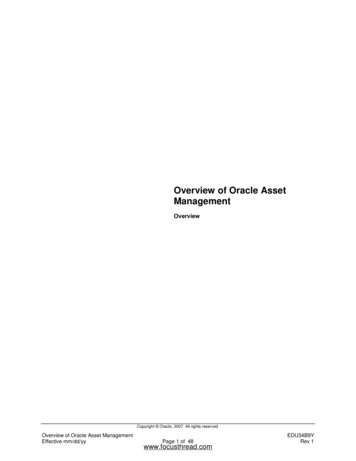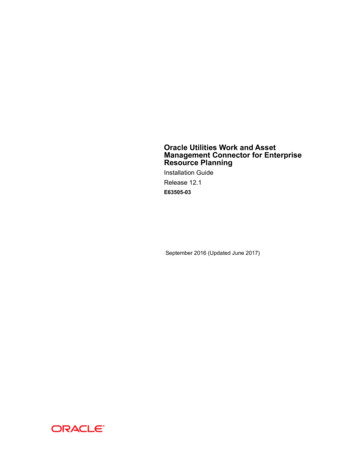
Transcription
Oracle Utilities Work and AssetManagement Connector for EnterpriseResource PlanningInstallation GuideRelease 12.1E63505-03September 2016 (Updated June 2017)
Oracle Utilities Work and Asset Management Connector for Enterprise Resource Planning, Release 12.1Installation GuideCopyright 2016, 2017 Oracle and/or its affiliates. All rights reserved.Primary Author: Oracle Corporation UGBU DocumentationThis software and related documentation are provided under a license agreement containing restrictions onuse and disclosure and are protected by intellectual property laws. Except as expressly permitted in yourlicense agreement or allowed by law, you may not use, copy, reproduce, translate, broadcast, modify, license,transmit, distribute, exhibit, perform, publish, or display any part, in any form, or by any means. Reverseengineering, disassembly, or decompilation of this software, unless required by law for interoperability, isprohibited.The information contained herein is subject to change without notice and is not warranted to be error-free. Ifyou find any errors, please report them to us in writing.If this is software or related documentation that is delivered to the U.S. Government or anyone licensing it onbehalf of the U.S. Government, then the following notice is applicable:U.S. GOVERNMENT END USERS: Oracle programs, including any operating system, integrated software,any programs installed on the hardware, and/or documentation, delivered to U.S. Government end users are"commercial computer software" pursuant to the applicable Federal Acquisition Regulation andagency-specific supplemental regulations. As such, use, duplication, disclosure, modification, and adaptation ofthe programs, including any operating system, integrated software, any programs installed on the hardware,and/or documentation, shall be subject to license terms and license restrictions applicable to the programs.No other rights are granted to the U.S. Government.This software or hardware is developed for general use in a variety of information management applications.It is not developed or intended for use in any inherently dangerous applications, including applications thatmay create a risk of personal injury. If you use this software or hardware in dangerous applications, then youshall be responsible to take all appropriate fail-safe, backup, redundancy, and other measures to ensure its safeuse. Oracle Corporation and its affiliates disclaim any liability for any damages caused by use of this softwareor hardware in dangerous applications.Oracle and Java are registered trademarks of Oracle and/or its affiliates. Other names may be trademarks oftheir respective owners.Intel and Intel Xeon are trademarks or registered trademarks of Intel Corporation. All SPARC trademarks areused under license and are trademarks or registered trademarks of SPARC International, Inc. AMD, Opteron,the AMD logo, and the AMD Opteron logo are trademarks or registered trademarks of Advanced MicroDevices. UNIX is a registered trademark of The Open Group.This software or hardware and documentation may provide access to or information about content, products,and services from third parties. Oracle Corporation and its affiliates are not responsible for and expresslydisclaim all warranties of any kind with respect to third-party content, products, and services unless otherwiseset forth in an applicable agreement between you and Oracle. Oracle Corporation and its affiliates will not beresponsible for any loss, costs, or damages incurred due to your access to or use of third-party content,products, or services, except as set forth in an applicable agreement between you and Oracle.
ContentsPreface. iAudience .iDocumentation and Resources .iDocumentation Accessibility .iiiConventions .iiiAbbreviations .iiiChapter 1Overview . 1-1Integration Pack Software Requirements .1-1Chapter 2Installation . 2-1Pre-Installation Tasks .2-1Installation Steps .2-2Configure Error Notification Rules (Optional) .2-4Verify Generated Artifacts .2-5JMS Server .2-6File Store .2-6JMS Module .2-7Sub Deployment .2-7JMS Adapter Outbound Connection Pool .2-8JMS Connection Factory .2-9Request/Response Queues .2-11Credential Map .2-12User Messaging Email Driver .2-12ESSAPP Schedules (Optional) .2-13SOA Partition .2-14Composites List .2-14Configure the Certificates of the Mail Server .2-16Configure the Edge Applications .2-17Security Policies .2-17Chapter 3Individual Composites . 3-1Deploy the Individual Composites .3-1Undeploy Composites .3-2Contents - iOracle Utilities Work and Asset Management Connector for Enterprise Resource Planning Installation Guide
Chapter 4Metadata Store (MDS) Artifacts . 4-1Deploy the MDS Folder .4-1Undeploy the MDS Folder .4-1Update MDS .4-2Chapter 5Installation Properties. 5-1Chapter 6Troubleshooting. 6-1Chapter 7Uninstalling the Integration . 7-1Uninstalling Linux Environments .7-1Uninstalling Windows Environments .7-2Uninstalling the UsageMessagingDriver-Email .7-2Contents - iiOracle Utilities Work and Asset Management Connector for Enterprise Resource Planning Installation Guide
PrefaceAudienceThis document is intended for anyone implementing the Oracle Utilities Work and AssetManagement Connector for Enterprise Resource Planning.Documentation and ResourcesFor more information regarding this integration, foundation technology and the edgeapplications, refer to the following documents:Product DocumentationTopicDescriptionIntegration documentation:Oracle Utilities Work and Asset ManagementConnector for Enterprise Resource PlanningRelease NotesOracle Utilities Work and Asset ManagementConnector for Enterprise Resource PlanningImplementation GuideOracle Utilities Work and Asset ManagementConnector for Enterprise Resource PlanningInstallation GuideRefer to the Oracle Utilities applicationsdocumentation page:http://docs.oracle.com/cd/E72219 01/documentation.htmlEdge application documentation:Oracle Utilities Work and Asset ManagementEnterprise Resource PlanningPreface - iOracle Utilities Work and Asset Management Connector for Enterprise Resource Planning Installation Guide
Documentation and ResourcesAdditional DocumentationResourceLocationSOA Suite 12c documentationRefer to the SOA documentation asuite/documentation/index.htmlOracle SupportVisit My Oracle Support at https://support.oracle.com regularly to stay informed aboutupdates and patches.Access the support site for the Edge ApplicationCertification Matrix for Oracle Utilities Products(Doc ID 1454143.1) or refer to the Oracle UtilitiesIntegrations page at roductinfo/utilities/integration/index.htmOracle Technology Network (OTN)Latest versions of tmlOracle Universityfor training opportunitieshttp://education.oracle.com/Web Services SecurityFor more information about Web services securityusing Oracle Fusion Middleware 12c refer to servicestasks.htm.Oracle Fusion Middleware 12cdocumentationRefer to the Oracle applications ware/Oracle Fusion Middleware “What'sNew In Oracle WebLogic Server”Section: Standards Support, SupportedConfigurations and WebLogic ServerCompatibility, dleware/1221/wls/NOTES/toc.htmFor additional information on the typeof database to use.Instructions on installing thisintegration on non-Windows/ LinuxplatformsRefer to Oracle Support Knowledge Article ID1349320.1.Preface - iiOracle Utilities Work and Asset Management Connector for Enterprise Resource Planning Installation Guide
Documentation AccessibilityDocumentation AccessibilityFor information about Oracle's commitment to accessibility, visit the Oracle AccessibilityProgram website at http://www.oracle.com/pls/topic/lookup?ctx acc&id docacc.Access to Oracle SupportOracle customers have access to electronic support for the hearing impaired. Visit:http://www.oracle.com/pls/topic/lookup?ctx acc&id info or http://www.oracle.com/pls/topic/lookup?ctx acc&id trsConventionsThe following text conventions are used in this document:ConventionMeaningboldfaceBoldface type indicates graphical user interface elements associated with anaction, or terms defined in text or the glossary.italicItalic type indicates book titles, emphasis, or placeholder variables for whichyou supply particular values.monospaceMonospace type indicates commands within a paragraph, URLs, code inexamples, text that appears on the screen, or text that you enter.AbbreviationsThis documentation includes the following terms:TermDefinitionABCSApplication Business Connector ServicesA requestor ABCS accepts the request from the client application through aclient-specific Application Business Message (ABM) and returns the responseto the client application through a client-specific ABM. The client side ABM isthe payload that is passed by the requestor application to the requestor ABCS.AIAOracle Application Integration ArchitectureAPAccounts PayableAPIApplication Programming InterfaceASTApplication Specific TechnologyBPELBusiness Process Execution LanguageDVMDomain Value MapEBMEnterprise Business Messages - Packets of data which the Mediator or JCAadapter accepts from requesters and routes to providers. They carry the piecesof data needed for the requests to be understood and serviced.EBO/EBFEnterprise Business ObjectPreface - iiiOracle Utilities Work and Asset Management Connector for Enterprise Resource Planning Installation Guide
AbbreviationsTermDefinitionEBSEnterprise Business ServiceEdgeapplicationThe applications that are involved in the two-way integration processes Oracle Utilities Work and Asset Management and other Enterprise ResourcePlanning applications.ERPEnterprise Resource PlanningESCEnterprise Resource Planning system Supply Chain business modelESSOracle Enterprise Scheduler ServiceGLGeneral LedgerJMSJava Message Service - The JMS producers are responsible for posting themessage to the Consumer JMS Queue for the corresponding targetapplication.JMS AdapterConsumerJMS adapter used in the SOA composite to read message from a queue isreferred to as a Consumer. The adapter has Consumer as a part of the name.For example, SyncWorkerOUWAMUtilitiesJMSConsumer.JMS AdapterProducerThe JMS adapter used in the SOA composite to write a message to a queue isreferred to as a Producer. The adapter has Producer as a part of the name. Forexample, SyncWorkerERPJMSProducer.MDSMetadata StoreParticipatingApplicationOne of the two applications involved in the two-way integration processesOracle Utilities Work and Asset Management, Enterprise Resource Planningsystem.PIPProcess Integration PackProviderProcessesAll the integration processes, which are invoked by the reading message fromthe queue are referred to as Provider Processes. These processes transform therequest message from the queue to the edge application format and executethe inbound service on the edge application with a message. These processeshave ProvABCSImpl as a part of the name. For example,SyncWorkerOUWAMUtilit iesProvABCSImpl.RequestorProcessesAll the integration processes, which are invoked by the edge applicationinitiating the request are referred to as Requestor Processes. These processesput the request message with or without transformation in the queue. Theseprocesses have ReqABCSImpl as a part of the name. For ed Architecture – Software modules that are provided asservices can be integrated or used by several applications using SOA, even iftheir respective architectures are substantially different. Rather than definingan API, SOA defines the interface in terms of protocols and functionality.SOAPSimple Object Access Protocol. It is a protocol specification for exchangingstructured information in the implementation of Web Services in computernetworks.WAM orOUWAMOracle Utilities Work and Asset ManagementWSCOracle Utilities Work and Asset Management Supply Chain business modelPreface - ivOracle Utilities Work and Asset Management Connector for Enterprise Resource Planning Installation Guide
AbbreviationsTermDefinitionXAIXML Application Integration. An Oracle Utilities Framework utility used toconfigure the system transfer information between Oracle Utilities Work andAsset Management and external applications using XML. XAI exposes systembusiness objects as a set of XML based web services. The service can beinvoked using different methods, for example, Hypertext Transfer Protocol(HTTP) or Java Message Service (JMS). Consequently, any application or toolthat can send and receive XML documents can access the rich set of systembusiness objects.XSDA schema definition file.XSLExtensible Style LanguagePreface - vOracle Utilities Work and Asset Management Connector for Enterprise Resource Planning Installation Guide
Chapter 1OverviewThis section provides information on prerequisites for installation of the Oracle UtilitiesWork and Asset Management Connector for Enterprise Resource Planning.Integration Pack Software RequirementsBefore installing the integration package, verify that the following applications areproperly installed and configured.Participating ApplicationsThe participating applications are: Oracle Utilities Work and Asset Management v2.1.1 latest patches appliedInstalled on an Oracle database. Enterprise Resource Planning ApplicationOracle SOA / WebLogic ServerThe server requirements include: WebLogic Server 12.2.1 with Oracle Enterprise Manager 12cOracle SOA Suite 12.2.1.0.0 Oracle Database 12.1.0.1 ; 11.2.0.4 Oracle attempts to support binary and source-level compatibilitybetween WebLogic Server 12c (12.2.1) and versions 10.3, 10.3.x, 12.1.1,12.1.2, and 12.1.3 in the areas of persistent data, generated classes, andAPI compatibility. In some cases, it is impossible to avoidincompatibilities. Where incompatibilities arise, they are fullydocumented in the Upgrading Oracle WebLogic Server guide.Note: Refer to the Oracle Utilities product Certification Matrix(referenced in the Documentation and Resources section) for the mostup to date supported edge application versions.Overview 1 - 1Oracle Utilities Work and Asset Management Connector for Enterprise Resource Planning Installation Guide
Chapter 2InstallationThis section describes the settings and requirements for a successful installation of theOracle Utilities Work and Asset Management Connector for Enterprise ResourcePlanning including: Pre-Installation Tasks Installation Steps Verify Generated Artifacts Configure the Certificates of the Mail Server Configure the Edge Applications Security PoliciesPre-Installation TasksThe following tasks should be completed before you install the integration:1. Verify that Oracle SOA Suite is installed and running.For more information, refer to the documentation at ite/documentation/index.html.2. Login to the WebLogic console to confirm there are no changes in PendingActivation status.3. Verify That the usermessagingdriver-email application is in Active state.If the application is in Installed state, then the application is not targeted to anymanaged server.a.Click Deployments.The summary of deployment opens.b. Click the usermessagingdriver-email link.c.Click on the Targets tab.d. Select the usermessagingdriver-email checkbox and click the ChangeTargets button.e.For standalone environments, select the soa server1 option.If it is the Clustered environment, select the cluster or all the clusters you wishto target to as soa Cluster1. Now, Click Yes button.f.Click on Activate Changes button.Installation 2 - 1Oracle Utilities Work and Asset Management Connector for Enterprise Resource Planning Installation Guide
Installation Steps4. Verify that the WebLogic Admin Server and the Standalone Managed Servers orClusters are in the Running status with their Health in OK state.Note: The syntax for PRODUCT HOME changes depending on whether you areinstalling on Linux or Windows. The following sections refer to this as PRODUCT HOME/ in Linux and as %PRODUCT HOME%\ in Windows. Ingeneral, note that the forward slash (/) is used as the path separator on Linux and theback slash (\) is used on Windows.Excusing any inadvertent syntax errors in this guide, these conventions should befollowed for all commands depending on your operating system.Also, as installation commands and arguments are lengthy, please copy the installationcommands in a text file and verify that the command is formatted correctly without anysyntax or formatting errors.Installation StepsComplete the following installation steps:1. Download the installation zip file from Oracle Software Delivery Cloud (https://edelivery.oracle.com).Note: For specific instructions about installing this integration on nonWindows/ Linux platforms, see Oracle Support Knowledge Article ID1349320.1(The process described refers specifically to the CCB-MDMintegration, however it applies any integration being installed onalternate platforms).2. Extract the zip file to get the installation folder.This folder includes subfolders such as bin, config, Install, MDS-Artifacts, andservices.3. Download and apply patch 23295348.a.Refer to the Readme.txt file and PatchInstallInstructions.txt files includedwith the patch for more information and installation instructions. The followingsub-steps provide more information related to the steps included in the Readmefile.Note: As indicated in the Readme.txt file, you must define or populate the valuesin the Install Properties xml file prior to installing the integration. Refer to Step 1in the PatchInstallInstructions.txt file included in the patch download.Refer to the Installation Properties chapter for information about individualproperties.b. Verify the environment variables for Linux and Windows OS:VariableExampleLinux and Windows OSPATCH HOMEXXX/23295348MW HOMEXXX/MiddlewareInstallation 2 - 2Oracle Utilities Work and Asset Management Connector for Enterprise Resource Planning Installation Guide
Installation StepsSOA HOMEXXX/Middleware/soaORACLE HOMEXXX/Middleware/soaPRODUCT HOMEThe product installation folder.Example:PRODUCT HOME /scratch/PRODUCT HOMES/WAM ERPThe commands indicated in the readme file (setWLSEnv.sh on Linux andsetWLSEnv.bat on Windows) set the environment variables used forexecuting the installation scripts.Below is an example to set up environment variables in a typical installation:LinuxexportexportexportsourceMW HOME /Oracle/Middleware/soaSOA HOME MW HOME/soaPRODUCT HOME /Product Homes/WAM ERP MW HOME/wlserver/server/bin/setWLSEnv.shWindowsSET MW HOME C:\Oracle\Middleware\soaSET SOA HOME %MW HOME%\soaSET PRODUCT HOME C:\Product Homes\WAM ERPcd %MW HOME%/wlserver/server/bin/setWLSEnv.cmdAlso note the following: PRODUCT HOME/install/util/ant folder contains all the ant build scripts. PRODUCT HOME/bin/InstallBuild.xml is used to install WAM ERPintegration code. PRODUCT HOME/bin/UnInstallBuild.xml is used to uninstallWAM ERP integration code. PRODUCT HOME/bin/DeployUndeployUtility.xml is used to deploy/undeploy individual composite/ MDS folder and then restart the managedserver.Note: The installation process may take several minutes to complete.4. Install the Integration.Follow the guidelines in step 4 in the PatchInstallInstructions.txt file included inthe patch download. This section provides additional detail to supplement thosesteps.The installDB commands perform the followings tasks: Create the Error Handling user for the integration. Create the Error Handling tables and Error Lookup tables. Insert the seed data that is used for Error Handling scenarios that occurduring the BPEL flow instances.Installation 2 - 3Oracle Utilities Work and Asset Management Connector for Enterprise Resource Planning Installation Guide
Installation StepsThe installWL commands perform the following tasks: Create the JDBC DataSource for the ErrorHandling Module. Create an outbound connection pool instance for the database by updatingthe DBAdapter WAM ERP.rar file. Create JMS server/JMS module/JMS connection pool/JMS persistencestore/JMS queues and assigns the error queues to the interface queues. Create JMS outbound connections to both Oracle Utilities Work and AssetManagement and Enterprise Resource Planning by updating theJMSAdapter WAM ERP.rar file. Create the csf key for the integration.The installSOA commands perform the following tasks: Update the MDS repository with all artifacts. Create the application partition where the composites are deployed.For example: WAM ERP. Compile and deploy all composites.Configure Error Notification Rules (Optional)The integration uses the Oracle Utilities common integration error handling framework,however if you want to use the SOA Suite 12c error hospital feature, you can implementit using the following guidelines.Error notification rule(s) can be created on the OUWAMERP partition using the ESSschedule to get the frequency of the error notification rule execution. To create errornotification rules at the partition level, perform the following steps:1. Right-click on the OUWAMERP partition.2. Select Error Notification Rules.The Error Notification Rules page opens.3. Click Create to create a new rule and enter the following information: Name DescriptionInstallation 2 - 4Oracle Utilities Work and Asset Management Connector for Enterprise Resource Planning Installation Guide
Verify Generated Artifacts Schedule Name (Select the schedule created through the scriptsOUWAMERPNotificationSchedule ) Use the IF-THEN table to define the fault notification rule, and click Apply.This table can be used to set the Fault conditions and also the email notificationaddress for the administrator.For more information about error hospital and error notifications, seethe section “Recovering From Faults in the Error Hospital” in Oracle Fusion Middleware Administering Oracle SOA Suite and OracleBusiness Process Management Suite documentation.Verify Generated ArtifactsAs a result of the installation, the following artifacts are created on the weblogic serverinstance.After completing the installation steps, complete the verification tasks to finalize theinstallation. JMS Server File Store JMS Module Sub Deployment JMS Adapter Outbound Connection Pool JMS Connection Factory Credential Map User Messaging Email Driver ESSAPP Schedules (Optional) SOA PartitionInstallation 2 - 5Oracle Utilities Work and Asset Management Connector for Enterprise Resource Planning Installation Guide
Verify Generated ArtifactsJMS ServerVerify OUWAMERPJMSServerIn the Administration console, under the Domain Structure, expand the Services (byclicking the sign next to it), expand the Messaging (by clicking the sign next to it),and then click JMS Servers.File StoreVerify OUWAMERPFileStoreIn the Administration console, under the Domain Structure, expand the Services (byclicking the sign next to it), and then click Persistent Store.Installation 2 - 6Oracle Utilities Work and Asset Management Connector for Enterprise Resource Planning Installation Guide
Verify Generated ArtifactsJMS ModuleVerify OUWAMERPJMSModuleIn the Administration console, under the Domain Structure, expand the Services (byclicking the sign next to it), expand the Messaging (by clicking the sign next to it),and then click JMS Modules.Sub DeploymentVerify OUWAMERPSubDeploy
Oracle Utilities Work and Asset Management and other Enterprise Resource Planning applications. ERP Enterprise Resource Planning ESC Enterprise Resource Planning system Supply Chain business model ESS Oracle Enterprise Scheduler Service GL General Ledger JMS Java Message Service - The JMS producers are responsible for posting the message to the .
